In the latest development from the Indo-Myanmar border, a mob stormed a hospital in Imphal on Thursday after reports of a “Kuki militant” from Myanmar being treated for bullet wounds came to the fore. Protesters from Imphal, the predominantly Meitei region, were dispersed with tear gas as they gathered outside the hospital, expressing discontent over the medical care provided to the 23-year-old who had crossed the Myanmar border with severe injuries sustained in an ethnic clash.
The Myanmar resident was identified as Khoantum from the Thanan village. The Assam Rifles said he sustained injuries in the internal conflict of his nation and walked to the nearest security forces post along the Indian border seeking medical assistance. Khoantum later succumbed to his injuries.
What is happening in Myanmar and how is it affecting India?
Since the 2021 military coup in Myanmar, the situation has rapidly deteriorated, marked by escalating violence and destruction, forcing thousands of Myanmar residents out of their homes and into neighbouring countries including the Northeastern Indian states. Manipur shares a 398 km border with Myanmar to its south and east. The Chin state, one of the most affected states of Myanmar, shares its boundary with Mizoram and Manipur
The intensifying crisis in Myanmar owing to the recent coordinated offensive, 'Operation 1027', poses a significant threat to the stability of the northeastern states of India, particularly Manipur. The situation becomes more complex with the involvement of the Chin National Front (CNF) from the Chin state, attempting to control parts of Myanmar's border with India. The CNF's successful takeover of two military outposts along the border has resulted in Myanmar soldiers crossing into India, where they were apprehended by security forces in Mizoram.
The close historical and cultural connections between the Kukis in Myanmar and Manipur are also being viewed as major concerns by authorities. The unrest in Myanmar can potentially spill over into Manipur, affecting regional stability.
Who are Myanmarese Kukis
Kukis are an ethnic tribe found in the tri-border area of Bangladesh, Myanmar and India. In Myanmar, they are found in the Chin State and Sagaing Region, in Bangladesh the Chittagong Hill Tracts district and in India the Northeastern states of Manipur, Mizoram, Nagaland, Assam, Meghalaya and Tripura.
The British referred to these tribes as Lushais, while the Burmese called them Chins. Historians suggest that the term "Kuki" is likely an exonym, meaning it was a name bestowed by outsiders rather than being native to the communities
The term 'Kuki' first appeared in colonial records in 1777 when tribe members attacked British subjects in Chittagong during Warren Hastings' term as Governor-General. In Manipur, Sir James Johnstone, the Political Agent, mentioned 'Kukis' between 1830 and 1840 in his book Manipur and the Naga Hills, according to historian Tuisem Ngakang.
Their history
Present-day Manipur is home to 33 Scheduled Tribes and seven Scheduled Castes. Most of the tribes under the recognised ST list identify either as Kuki or the Naga.
Manipur has historically been an independent kingdom ruled by dynasties of Meitei rulers. The royal chronicles, known as Cheitharol Kumbaba, document the history of Manipuri kings from the Ningthouja dynasty dating back to 33 AD. Although there are archaeological records of human civilization in the Imphal valley from before 33 AD, it is difficult to associate them specifically with the Meitei people.
Historians believe that the boundaries of rulers’ kingdoms kept expanding and shrinking based on their power. Although, it is believed that despite conquests Meiti kings’ dominance was mainly confined to the valley. The Treaty of Yandaboo fixed the boundary between Manipur and Burma in 1826.
According to the 1881 Census conducted by the British administration, there were 30,000 to 40,000 Kukis and Nagas in present-day Manipur. The British divided the Kuki tribes into two groups – the "Old Kuki" who lived in the state traditionally, and the "New Kuki" who migrated from Lushai Hills in the early 19th century, also known as Kongjai Kukis by the Meiteis.
According to the Gazetteer of Manipur (1886), there were approximately 8,000 'Old Kukis' who traditionally lived in the state, and about 17,000 "New Kukis" who migrated from Lushai Hills during the early 19th century.
The British, in the early 19th century, strategically placed the 'New Kukis' around the Manipur valley as mercenaries to act as a buffer against Naga tribe raids. They implemented a policy of balance between tribes, resulting in the establishment of Kuki villages alongside Naga villages, creating a diverse population in the hills despite inter-tribe rivalries.
Historians believe that the Kuki-Chin migration from Myanmar to Manipur has been happening for decades now. It has occurred in three main phases: late 1950s and early 1960s during a civil war, before and after the August 1988 uprising, and after a ceasefire between Indian security forces and Kuki militants in 2005. Historically, these migrations did not result in conflicts as is happening now.
Aversion towards Kukis on being dubbed illegal immigrants
Kuki communities are facing hostility from the Manipur Meitei community and are being dubbed as “illegal immigrants” as they cross the Indo-Myanmar border seeking refuge.
The Kuki communities from Chin and Sagaing regions, which have been most affected by clashes, have faced large-scale displacement and fled into neighbouring areas.
While the Kuki-Chin people, who sought refuge in Mizoram where they constitute the majority, have been cared for by the state government on humanitarian grounds, their migration to Manipur has stirred controversy.
Spokesperson of the Coordinating Committee Athouba Khuraijam, told Union Minister Amit Shah during a meeting that at the root of the current crisis is “narco-terrorism involving illegal Kuki-Chin immigrants from Myanmar, cross-border Kuki insurgent groups, and Myanmar-based drug cartels.”
In response, spokesperson for Indigenous Tribal Leaders Forum (ITLF) Ginza Vualzong said, “Of course, some Kuki-Chin people have crossed over from Myanmar over the years due to the hostile situation there but that has never been in any alarming numbers at all. We have told the home minister that immigration is being used as an excuse to drive Manipur’s indigenous Kuki population out of their land.”



























